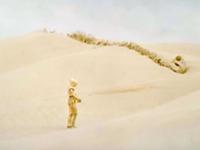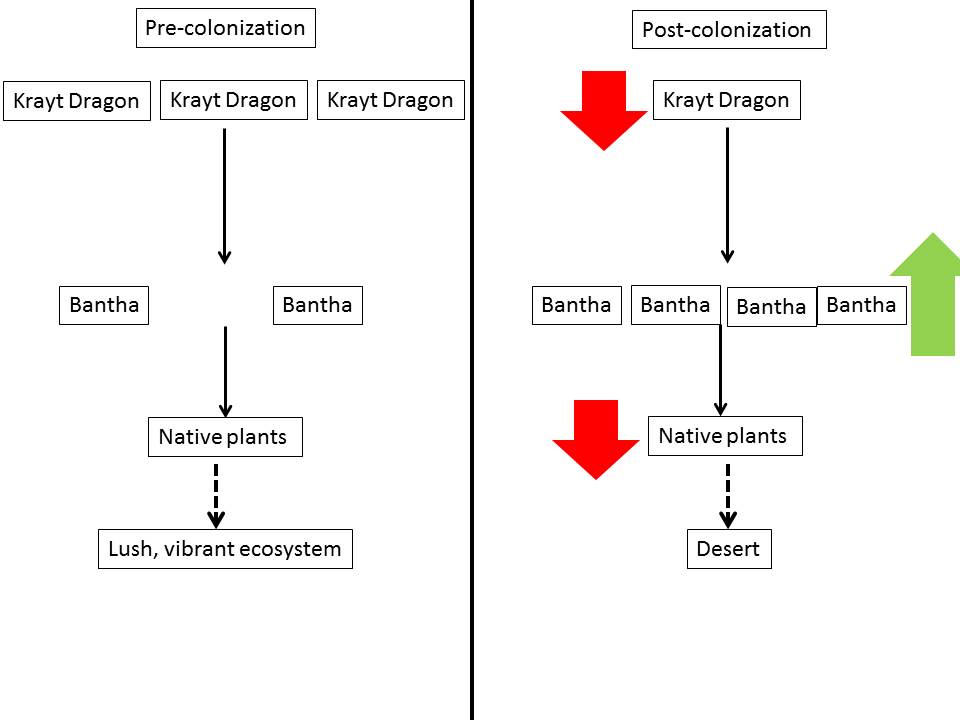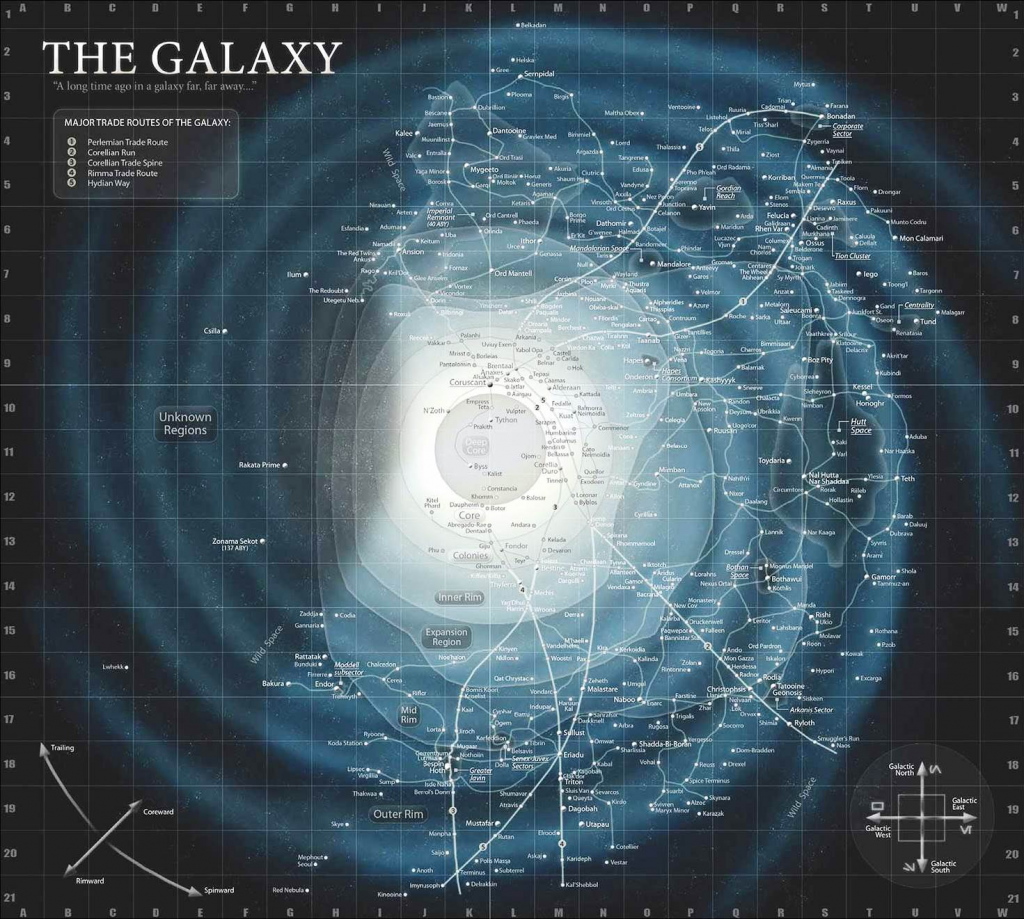Author’s note: this post is part of the “Science of Tatooine” blog carnival. Though obviously about science fiction and not the real world, it includes real ecological theories, and it uses some real peer-reviewed scientific papers as references. Whenever possible, I’ve linked to accessible copies of those papers and explainers of these ecological terms. Many of the same issues are associated with shark population declines.
ABSTRACT
Predators play an important role in structuring ecosystems, with predator population declines being linked to a variety of negative ecological effects. Here, we present evidence that the planet Tatooine, famous throughout the Galaxy for being a desert planet, experienced desertification as a result of unintended changes in herbivore populations caused by the intentional large-scale killing of apex predators by offworld colonists. Fossil evidence and interviews showing traditional ecological knowledge suggest that once-abundant Krayt dragons were hunted to near extinction by early human colonists. As a result of the decline in predation, populations of large herbivorous banthas populations grew out of control and overgrazed the plants once found throughout Tatooine.
INTRODUCTION
Studies of numerous ecosystems have consistently shown the importance of intact populations predators to healthy ecosystems, with a recent review (Estes et al. 2011 “trophic downgrading of planet Earth”) noting that “the loss of apex consumers is arguably humankind’s most pervasive influence on the natural world.” Population declines of top predators can cause a trophic cascade, resulting in unintended consequences that ripple through a food chain. Sea otter population declines in the Pacific Northwest of the United States resulted in predation release of otter prey (sea urchins), and an overabundance of sea urchins destroyed entire kelp forest ecosystems by overgrazing (Estes et al. 1998 “killer whale predation on sea otters linking oceanic and nearshore systems.) Wolf population declines in Yellowstone National Park resulted in predation release of wolf prey (elk,) and an overabundance of elk destroyed aspen pine forests by overgrazing (Ripple et al. 2011 “trophic cascades among wolves, elk, and aspen on Yellowstone National Park’s northern range.”) Ecosystem-wide effects stemming from the loss of predators has also been listed as the proximate cause of disease outbreaks (Pongsiri et al. 2009 “biodiversity loss affects global disease ecology,”), increasing destructive wildfires (Perrings et al. 1997 “biodiversity resilience and the control of ecological-economic systems: the case of fire-driven rangelands,”) and overall biodiversity loss (Paine 1969, “Pisaster-tegular interaction: prey patches, predator food preference, and intertidal community structure.”)
Though the planet Tatooine in the Tatoo system of the Outer Rim is known by researchers to have once been covered by oceans and lush vegetation, it is commonly known now as a desert planet (source). While it is famous in Republic circles primarily for being the home of Jedi Master Skywalker, Tatooine also has native sentient species, including Jawas and Tusken Raiders (the latter are derisively referred to by locals as “sand people” ). Native non-sentient animals include banthas (large herbivores used as beasts of burden) and the now mostly extinct Krayt dragon (a large predatory species that fed on banthas).
METHODS
Our research team visited Tatooine (Figure 1) to conduct an extensive biological, paleontological, and sociological survey of the planet. The biology, behavior and diet of herbivorous banthas was examined through wild observation and captive trials. Members of indigenous species were extensively interviewed about their records and cultural memories of the ecosystem and wildlife of Tatooine. Krayt dragon skeletons were analyzed to determine their past biology and behavior.
Figure 1: Study site of Tatooine is located on R18 of this map.
Map source: http://starwars.wikia.com/wiki/The_galaxy
RESULTS
Krayt dragons (Figure 2) are now mostly extinct (source). Our data, a combination of historical records from colonists, wild population surveys, and interviews with indigenous populations, suggests that wild populations have declined by more than 97% since the days before human colonization of Tatooine. Stable isotope analysis performed on skeletons suggest that Krayt dragon diets consisted primarily of herbivorous banthas.

While Republic citizens are frequently dismissive of Tatooine (Master Skywalker said of Tatooine “if there’s a bright center to the universe, you’re on the planet that it’s farthest from,” ) indigenous sentient species sadly point out that it wasn’t always this way. “Oh, Tatooine was a beautiful place,” a Jawa Clan Chief told us in an interview that was frequently interrupted by attempts to sell us broken pieces of technology. “Lush forests, a huge ocean full of fish to eat, it was a paradise.” The Jawas now roam Tatooine in huge terrestrial vehicles known as “sandcrawlers” that keep them out of the heat, but the Clan Chief told us that these vehicles were originally designed to allow Jawas to safely move between trading posts without being attacked by Krayt dragons. “We haven’t seen a Krayt in generations, though,” he told us. He also told us of many beautiful and fascinating species of plants and animals that lived in the now-gone forests, all extinct now due to desertification.
Interviews with Tusken Raiders proved complex, as the species is distrustful of (and hostile to) foreigners, but a Tusken Storyteller we interviewed blamed ancient offworld “outlander” colonists for the destruction of the natural resources of Tatooine and the resulting changes in their species’ culture. Tusken Raiders were not always a nomadic desert people, and they long ago (then called Ghorfa) had vast settlements with a high standard of living and relatively advanced technology (source). A group of offworlders that Tuskens call “the builders” changed that, disrupting Tattooine’s ecosystem and necessitating a switch to a nomadic lifestyle with a much lower standard of living. The Storyteller told us that his species valued (some tribes even worshipped) Krayt dragons, and were devastated to witness offworlders killing them on such a large scale. Bantha populations quickly began to increase, he reported, and Tuskens learned to domesticate some of them. Bantha numbers grew out of control, and the Storyteller relayed a Tusken fable, similar to the Earth tale of greed killing the goose that laid golden eggs, that suggested that ancient Bantha overgrazing helped turn Tatooine into the desert world it is today. (Paleontological records agree that bantha populations greatly increased, between 1,000 and 25,000%, shortly after the arrival of humans).
These results suggest an trophic cascade: that the extirpation of apex predatory Krayt dragons by early offworld settlers caused predation release in herbivorous banthas, which overgrazed native flora until a tipping point was reached and Tatooine experienced desertification (Figure 3).

DISCUSSION
Our results suggest that unsustainable predator culls by ancient offworld colonists may be to blame for the desertification of Tatooine, as well as the resulting biodiversity loss and cultural changes in indigenous sentient species. This has important consequences in the ongoing debate over the historical legacy of the Colonization Act and attempts by some Core World political leaders to reinstate it in the New Republic. Though strict regulations surround the use of terraforming technology on an inhabited world, less care is taken to ensure that colonist activities have a minimal unintentional impact on the native biosphere of colonized planets.
ACKNOWLEDGMENTS
The authors would like to thank the General Ministry of the New Republic for their funding of this research expedition, two anonymous reviewers for their helpful feedback in improving this manuscript, and Matt Shipman for organizing this special collection of research related to Tatooine.
Please be sure to read other posts in the science of Tatooine blog carnival, including:
Why are a bunch of science writers writing about a fictional planet? by Matt Shipman
Report from the Tatooine intergovernmental panel on climate change by David Ng
Functional anatomy of Tatooine megafauna by John Hutchinson
Science of Tatooine: water by Adrienne Roehrich
Tatooine’s Tangled bank: plants evolve in a galaxy far, far, away by Malcom Campbell
